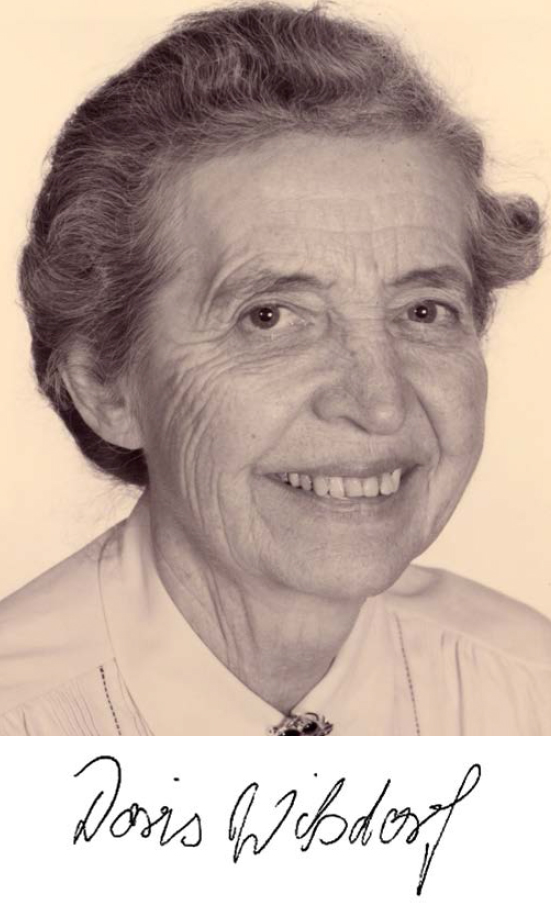DORIS KUHLMANN-WILSDORF
1922–2010
Elected in 1994
“For contributions to dislocation theory and its application to mechanical behavior.”
BY BHATKA B. RATH AND EDGAR A. STARKE, JR.
DORIS KUHLMANN-WILSDORF, a pioneer in science education, crystal plasticity, mechanical properties, and the theory of crystal defects, died March 25, 2010, at the age of 88.
She was born in Bremen, Germany, on February 15, 1922, to Adolph Friedrich and Elsa Kuhlmann. Before entering the University of Göttingen in 1942, she worked as an apprentice metallographer and materials tester (1940–1942) and developed her lifelong love of science. She completed her undergraduate work in metallurgy in 1944, her master’s degree in physics in 1946, and her doctor of philosophy in materials science in 1947, all at the University of Göttingen.
A dedicated student and researcher, Doris continued working in her laboratory even after Allied bombs blew out the windows during World War II. She emigrated to England in 1949 and studied with Nobel Laurate Sir Nevill Francis Mott at the University of Bristol.
On January 4, 1950, she married Heinz G.F. Wilsdorf, a gifted experimentalist, whom she had met at the University of Göttingen. Shortly after their wedding they moved to South Africa where she became a lecturer in physics at the University of the Witwatersrand and Heinz was employed as a scientist at the Council for Scientific and Industrial Research in Pretoria.
Doris received an honorary doctor of science degree from the University of the Witwatersrand in 1955.
After the birth of their two children, Gabriele and Michael, they moved to the United States in 1956. Doris joined the faculty of the University of Pennsylvania and Heinz accepted a position at the Franklin Institute.
In 1963 Doris was offered a faculty position at the University of Virginia, a predominantly male institution, as the first woman professor of engineering physics. She came to the university as part of a two-career-couple, as Heinz was invited to chair the newly established Department of Materials Science. Doris survived the resentment and sometimes overt discrimination of the all-male faculty, and in time came to love the university. She was promoted to University Professor of Applied Science in 1966, the highest academic rank at the university, a position she held for 40 years.
Doris Kuhlmann-Wilsdorf was internationally recognized for her path-breaking work in plastic deformation, surface physics, and crystal defects. She developed a unified theory of plasticity for dislocation behavior. One of her most important achievements was the development of metal fiber brushes for use as sliding electrical contacts in electric motors, for which she was granted six patents. She published more than 300 scientific papers and started two companies.
Her many honors include the 1988 Heyn Medal from the German Society for Materials Science for her work on the theory of metal deformation; the Ragnar Holm Scientific Achievement Award from the Institute of Electrical and Electronics Engineers in 1991; and the University of Virginia’s Christopher J. Henderson Inventor of the Year Award in recognition of her research relating to electrical brushes in 2001. In 2004 she received an honorary doctorate from the University of Pretoria. She was also an active member of the Society of Women Engineers.
In 2001 a former student of the Department of Materials Science and Engineering at the University of Virginia, Gregory H. Olsen, provided most of the funding for a new materials science building to be named in honor of Doris Kuhlmann-Wilsdorf and Heinz Wilsdorf.
After her official retirement from the university in 2005, Doris taught a university seminar course in science and religion, continued her research, and participated in the Semester at Sea program.
With an insatiable appetite for knowledge and a gift for correctly understanding the whys of phenomena, she coupled those qualities with a forceful personality and ability to persuade others of her views. These characteristics greatly contributed to her success and wide recognition.
She had a keen mind and could leapfrog in her thinking so much that it was hard to keep up with her—and, to quote Frank R.N. Nabarro, “she has an uncanny ability to be right for no apparent reason.” These attributes allowed her to make great strides in scientific interchanges.
Perhaps surprising is that accompanying her sharp mind was a generosity and appreciation of others that endeared her to associates, students, family, and friends. Everyone was her extended family and she supported them with her time, resources, and attention. Her friendships were enduring and interactions frequent. She was quick to give a wide friendly smile.
With a desire to be helpful to individuals and leave a legacy to science as well as society generally, she championed causes across a range of issues. She led universitywide discussions on evolution, apartheid, and honesty. Insights into the nature of the universe led her to write a book on the relationship between science and religion in addition to her popular course on the subject.
After her husband suffered a stroke that left him wheelchair bound she devoted herself to his care. She even designed a rope-and-pulley system to ease his transition into the water-therapy spa.
The deaths of her two treasured children, Gabriele in 1969 and Michael in 1979, and her husband Heinz in 2000, were crushing blows. But Doris remained warm, friendly, and intellectually engaged throughout her life and touched many people with her charm and wit.
She is survived by her niece and nephew Evelyn and René Kalous of Germany, and close family friend Gretchen Watkins of Charlottesville.





